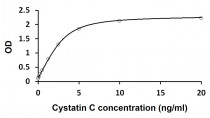ARG54135
anti-CST3 / Cystatin C antibody
anti-CST3 / Cystatin C antibody for ELISA and Human
Cell Biology and Cellular Response antibody; Cell Death antibody; Controls and Markers antibody; Developmental Biology antibody
Overview
| Product Description | Mouse Monoclonal antibody recognizes CST3 / Cystatin C |
|---|---|
| Tested Reactivity | Hu |
| Tested Application | ELISA |
| Host | Mouse |
| Clonality | Monoclonal |
| Isotype | IgG1 |
| Target Name | CST3 / Cystatin C |
| Antigen Species | Human |
| Immunogen | Recombinant human cystatin c protein. |
| Conjugation | Un-conjugated |
| Alternate Names | Cystatin-C; Neuroendocrine basic polypeptide; Post-gamma-globulin; ARMD11; Cystatin-3; Gamma-trace |
Application Instructions
| Application Suggestion |
|
||||
|---|---|---|---|---|---|
| Application Note | Sandwich ELISA (Capture antibody - Detection antibody): ARG54134 (4 µg/ml) - ARG54135 (0.5 µg/ml) * The dilutions indicate recommended starting dilutions and the optimal dilutions or concentrations should be determined by the scientist. |
||||
| Observed Size | 13 kDa |
Properties
| Form | Liquid |
|---|---|
| Storage Instruction | For continuous use, store undiluted antibody at 2-8°C for up to a week. For long-term storage, aliquot and store at -20°C or below. Storage in frost free freezers is not recommended. Avoid repeated freeze/thaw cycles. Suggest spin the vial prior to opening. The antibody solution should be gently mixed before use. |
| Note | For laboratory research only, not for drug, diagnostic or other use. |
Bioinformation
| Database Links | |
|---|---|
| Gene Symbol | CST3 |
| Gene Full Name | cystatin C |
| Background | Cystatin C or cystatin 3 (formerly gamma trace, post-gamma-globulin or neuroendocrine basic polypeptide), a protein encoded by the CST3 gene,is mainly used as a biomarker of kidney function. Recently, it has been studied for its role in predicting new-onset or deteriorating cardiovascular disease. It also seems to play a role in brain disorders involving amyloid (a specific type of protein deposition), such as Alzheimer´s disease. In humans, all cells with a nucleus (cell core containing the DNA) produce cystatin C as a chain of 120 amino acids. It is found in virtually all tissues and body fluids. It is a potent inhibitor of lysosomal proteinases (enzymes from a special subunit of the cell that break down proteins) and probably one of the most important extracellular inhibitors of cysteine proteases (it prevents the breakdown of proteins outside the cell by a specific type of protein degrading enzymes). Cystatin C belongs to the type 2 cystatin gene family. |
| Function | As an inhibitor of cysteine proteinases, this protein is thought to serve an important physiological role as a local regulator of this enzyme activity. [UniProt] |
| Research Area | Cell Biology and Cellular Response antibody; Cell Death antibody; Controls and Markers antibody; Developmental Biology antibody |
| Calculated MW | 16 kDa |
| PTM | The Thr-25 variant is O-glycosylated with a core 1 or possibly core 8 glycan. The signal peptide of the O-glycosylated Thr-25 variant is cleaved between Ala-20 and Val-21. |
Images (1) Click the Picture to Zoom In
-
ARG54135 anti-CST3 / Cystatin C antibody ELISA image
Standard Curve: Capture antibody: ARG54134 anti-CST3 / Cystatin C antibody at 4 µg/ml; Detector antibody: ARG54135 anti-CST3 / Cystatin C antibody at 0.5 µg/ml. These products result of a typical standard run with optical density reading at 450 nm.






